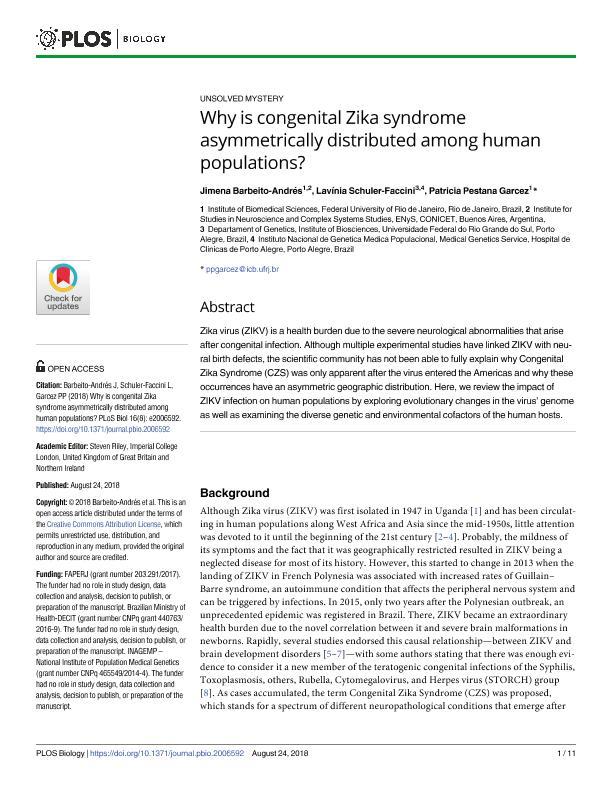Mostrar el registro sencillo del ítem
dc.contributor.author
Barbeito Andrés, Jimena

dc.contributor.author
Schuler Faccini, Lavínia
dc.contributor.author
Garcez, Patricia Pestana
dc.date.available
2020-01-31T20:26:32Z
dc.date.issued
2018-08
dc.identifier.citation
Barbeito Andrés, Jimena; Schuler Faccini, Lavínia; Garcez, Patricia Pestana; Why is congenital Zika syndrome asymmetrically distributed among human populations?; Public Library of Science; PLoS Biology; 16; 8; 8-2018; 1-11
dc.identifier.issn
1544-9173
dc.identifier.uri
http://hdl.handle.net/11336/96440
dc.description.abstract
Zika virus (ZIKV) is a health burden due to the severe neurological abnormalities that arise after congenital infection. Although multiple experimental studies have linked ZIKV with neural birth defects, the scientific community has not been able to fully explain why Congenital Zika Syndrome (CZS) was only apparent after the virus entered the Americas and why these occurrences have an asymmetric geographic distribution. Here, we review the impact of ZIKV infection on human populations by exploring evolutionary changes in the virus’ genome as well as examining the diverse genetic and environmental cofactors of the human hosts.
dc.format
application/pdf
dc.language.iso
eng
dc.publisher
Public Library of Science

dc.rights
info:eu-repo/semantics/openAccess
dc.rights.uri
https://creativecommons.org/licenses/by-nc-sa/2.5/ar/
dc.subject
BRAIN
dc.subject
DEVELOPMENT
dc.subject
STORCH
dc.subject.classification
Otros Tópicos Biológicos

dc.subject.classification
Ciencias Biológicas

dc.subject.classification
CIENCIAS NATURALES Y EXACTAS

dc.title
Why is congenital Zika syndrome asymmetrically distributed among human populations?
dc.type
info:eu-repo/semantics/article
dc.type
info:ar-repo/semantics/artículo
dc.type
info:eu-repo/semantics/publishedVersion
dc.date.updated
2019-10-16T18:28:14Z
dc.journal.volume
16
dc.journal.number
8
dc.journal.pagination
1-11
dc.journal.pais
Estados Unidos

dc.journal.ciudad
San Francisco
dc.description.fil
Fil: Barbeito Andrés, Jimena. Universidad Nacional Arturo Jauretche. Unidad Ejecutora de Estudios en Neurociencias y Sistemas Complejos. Provincia de Buenos Aires. Ministerio de Salud. Hospital Alta Complejidad en Red El Cruce Dr. Néstor Carlos Kirchner Samic. Unidad Ejecutora de Estudios en Neurociencias y Sistemas Complejos. Consejo Nacional de Investigaciones Científicas y Técnicas. Centro Científico Tecnológico Conicet - La Plata. Unidad Ejecutora de Estudios en Neurociencias y Sistemas Complejos; Argentina
dc.description.fil
Fil: Schuler-Faccini, Lavínia. Universidade Federal do Rio Grande do Sul; Brasil
dc.description.fil
Fil: Garcez, Patricia Pestana. Universidade Federal do Rio de Janeiro; Brasil
dc.journal.title
PLoS Biology

dc.relation.alternativeid
info:eu-repo/semantics/altIdentifier/url/http://dx.plos.org/10.1371/journal.pbio.2006592
dc.relation.alternativeid
info:eu-repo/semantics/altIdentifier/doi/http://dx.doi.org/10.1371/journal.pbio.2006592
Archivos asociados
